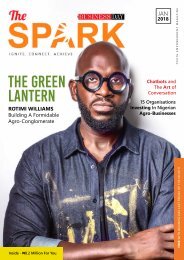May 2018
Create successful ePaper yourself
Turn your PDF publications into a flip-book with our unique Google optimized e-Paper software.
The Spark | Ignite/Connect/Achieve www.thesparkng.com www.thesparkng.com The Spark | Ignite/Connect/Achieve<br />
There is a difference between critical, analytical and<br />
strategic thinking in the context of solving a problem.<br />
Take this article as Part One in a series. We will try to<br />
unbundle and define popularly used terms yet largely<br />
mis-understood in the business world. Fundamental<br />
understanding of a subject is critical to succeeding at<br />
it. The article will examine the above topic.<br />
- By Emmanuel Tarfa<br />
Critical Thinking is the ability to generate an exhaustive<br />
potential LIST of the most relevant and possible<br />
assumptions or options – to explaining or solving a given<br />
problem. This LIST is usually arranged from the most relevant to<br />
the least relevant assumptions/options.<br />
A concept called Mutually Exclusive and Collectively Exhaustive<br />
(MECE), popularly used by strategy consultants, can be used to<br />
arrange/organise the list. Success is measured here by the length<br />
and quality/variety of ideas on the list.<br />
Here is an illustration and application: Why is the quality of<br />
education poor in Nigeria and how can it be improved? Critical<br />
thinking will require the subject involved to generate a list of<br />
points to answer the first part of the question and will include<br />
points such as:<br />
• Lack of a clear education strategy and policy framework,<br />
• Poor quality of teacher training and compensation<br />
• Low level of investment in infrastructure, etc.<br />
START UP<br />
Fundamental Thought<br />
Processes<br />
The length of the list (number of ideas/points generated) and<br />
quality of each answer (i.e. coming up with the most likely<br />
accurate points) will require critical thinking.<br />
Analytical Thinking is the use of quantitative and qualitative<br />
parameters/tools (size, average, cost, comparison etc.) to<br />
determine or measure which of the assumption/points are<br />
most accurate and relevant to solving the problem/validating<br />
the solution. Success here is measured when there is a logic or<br />
outright evidence to confirm the above points outlined through<br />
“critical thinking” are TRUE and relevant to answering the<br />
question or solving the problem. This has moved from a “guess”<br />
i.e. assumptions, to confirmed points.<br />
Here is the application using the example above – Why the<br />
quality of education in Nigeria is poor. Analytical thinking will<br />
take each answer above and test if true and required to answer the key<br />
question or solve the problem. Let us take one of the answers – poor<br />
quality of teacher training and compensation. Analytical thinking will strive<br />
to ask and answer several questions and sometimes compare Nigeria with<br />
other countries in its development league and other advanced economies<br />
– to confirm the points/assumptions generated with critical thinking.<br />
Here are some questions that could be used to conduct the analysis:<br />
• What is the average student to teacher ratio in Nigeria?<br />
• What is the average pay per teacher in a public school?<br />
• What is the minimum qualification of a teacher and frequency of<br />
training?<br />
All these will be compared with best practices to confirm Nigeria’s position<br />
and hence answer the question – why the quality of education is poor.<br />
Analytical thinking will subsequently show the link between the answers<br />
(the situation in Nigeria) – indicating that Nigerian teachers are not very<br />
qualified and poorly compensated. Do note that these are simply basic<br />
examples. Much deeper analysis is actually used in strategy.<br />
Strategic Thinking is the ability to DECIDE and prioritize (due to limited<br />
resources) which validated/true options above should be considered,<br />
presented or pursued – with the aim of achieving a pre-determined<br />
objective or goal. Success here is measured when there is a conversion<br />
of the knowledge/data of the truth “analyzed” above into profit/benefit/<br />
competitive advantage through good decision making. The above<br />
example will be applicable if there is an objective to solve the challenge of<br />
quality education, for instance.<br />
Let us again look at the point – quality of teacher training and compensation<br />
as a way to improve the quality education in Nigeria. Strategic thinking<br />
will recommend how to improve Nigeria’s current state (which was<br />
determined using critical and analytical thinking). It will outline a set of<br />
ideas, using the benchmarks of other countries with higher educational<br />
standards – and recommend how to close the gap in Nigeria.<br />
To improve in all three, read more Newspapers, which are usually filled<br />
with analysis and listen to commentary from experts. Take note of their<br />
approach and thinking. A good knowledge of Mathematics is also helpful<br />
in becoming more analytical. We will look at the difference between<br />
Vision, Mission and Core Values in our next article.<br />
A good knowledge of<br />
Mathematics is helpful in<br />
“becoming more analytical<br />
“<br />
28 29<br />
@thesparkng<br />
@thesparkng








